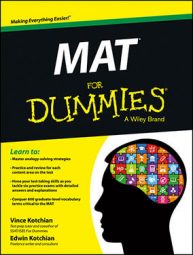The Miller Analogies Test (MAT) requires knowledge about a variety of subjects, and increasing your vocabulary is key to success on the MAT. Mnemonics are powerful tools for helping you master a vast vocabulary.
When you’re learning vocabulary, unless you give your brain a way to hold on to the words you learn, it will probably have a harder time remembering them when they appear on the MAT.
Some examples of mnemonics
A mnemonic is just a memory device. It works by creating a link in your brain to something else so that recalling one thing helps recall the other. You can use mnemonics in many ways, but the strongest links are through senses and emotions.
Consider this example:
Quash (verb): to completely stop from happening.
Think: squash
The best way to QUASH an invasion of ants in your kitchen is simple: SQUASH them.
Now your brain has a link from the word quash (which it may not have known) to the word squash (which it probably knows). Both words sound and look the same, so creating a visual and aural link is easy. If you picture someone squashing ants (and maybe get grossed out), you have another visual link and an emotional link.
Here’s another example:
Eschew (verb): to avoid.
Think: Ah-choo!
ESCHEW people who say “AH-CHOO!” unless you want to catch their colds.
The word eschew sounds similar to someone sneezing (ah-choo!), so your brain links the two sounds. If you picture yourself avoiding someone who is about to sneeze in your face, even better!
The more connections you make in your brain to the new word, the easier it is to recall it.
Make your own mnemonics
When you have a chance to check out some of the vocabulary words you’ve assembled, you’re ready to make your own mnemonics for words. Have fun with this — be creative in the connections you make, but above all, be sure your mnemonics are memorable for you.
Think about another word that looks like either your vocabulary word or a word that rhymes with it. Then try to make a creative, vivid, and/or funny sentence that links the vocabulary word to the word you already know.
Creating a link from something you don’t know to something you do know is the key, as is making it emotional and vivid.

